
Heavy Equipment Transporter System (HETS) is the name of a U.S. Army logistics vehicle transport system, the primary purpose of which is to transport the M1 Abrams tank. It is also used to transport, deploy, and evacuate armored personnel carriers, self-propelled artillery, armored bulldozers, and other heavy vehicles and equipment.
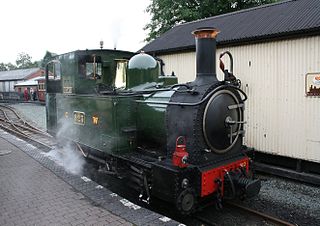
The Welshpool & Llanfair Light Railway (W&LLR) is a 2 ft 6 in narrow gauge heritage railway in Powys, Wales. The line is around 8.5 miles (13.7 km) long and runs westwards from the town of Welshpool via Castle Caereinion to the village of Llanfair Caereinion.

A railroad car, railcar, railway wagon, railway carriage, railway truck, railwagon, railcarriage or railtruck, also called a train car, train wagon, train carriage or train truck, is a vehicle used for the carrying of cargo or passengers on a rail transport system. Such cars, when coupled together and hauled by one or more locomotives, form a train. Alternatively, some passenger cars are self-propelled in which case they may be either single railcars or make up multiple units.

Piggyback transportation refers to the transportation of goods where one transportation unit is carried on the back of something else. It is a specialised form of intermodal transportation and combined transport.

The Narrow Gauge Railway Museum is a purpose-built museum dedicated to narrow-gauge railways situated at the Tywyn Wharf station of the Talyllyn Railway in Tywyn, Gwynedd, Wales.
The Leek and Manifold Valley Light Railway (L&MVLR) was a narrow gauge railway in Staffordshire, England that operated between 1904 and 1934. The line mainly carried milk from dairies in the region, acting as a feeder to the 4 ft 8 1⁄2 instandard gauge system. It also provided passenger services to the small villages and beauty spots along its route. The line was built to a 2 ft 6 in narrow gauge and to the light rail standards provided by the Light Railways Act 1896 to reduce construction costs.
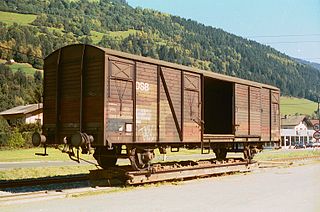
A transporter wagon, in railway terminology, is a wagon (UIC) or railroad car (US) designed to carry other railway equipment. Normally, it is used to transport equipment of a different rail gauge. In most cases, a transporter wagon is a narrower gauge wagon for transporting a wider gauge equipment, allowing freight in a wider gauge wagons to reach destinations on the narrower gauge network without the expense and time of transshipment into a narrower gauge wagons.

With railways, a break of gauge occurs where a line of one gauge meets a line of a different gauge: specifically a different track gauge. Trains and rolling stock cannot run through without some form of conversion between gauges, and freight and passengers must otherwise be transshipped. A break of gauge adds delays, cost, and inconvenience.
Scammell Lorries Limited was a British manufacturer of trucks, particularly specialist and military off-highway vehicles, between 1921 and 1988.
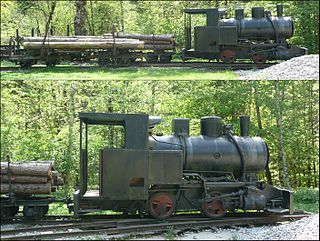
Tramways are lightly laid railways, sometimes with the wagons or carriages moved without locomotives. Because individual tramway vehicles are not intended to carry the weight of typical standard-gauge railway equipment, the tramways over which they operate may be built from less substantial materials. Tramways can take many forms; sometimes just tracks temporarily placed on the ground to transport materials around a factory, mine or quarry. Many, if not most, use narrow-gauge railway technology. The trains can be manually pushed by hand, pulled by animals, cable hauled by a stationary engine, or use small, light locomotives. At the other extreme they could be complex and lengthy systems, such as the Lee Moor Tramway in the county of Devon, England, in the United Kingdom.

Rollbocks, sometimes called transporter trailers, are narrow gauge railway trucks or bogies that allow a standard gauge wagon to 'piggyback' on a narrow-gauge line. The Vevey system enables a coupled train of standard gauge wagons to be automatically loaded or rolled onto Rollbocks, so that the train can then continue through a change of gauge.

Trench railways represented military adaptation of early 20th century railway technology to the problem of keeping soldiers supplied during the static trench warfare phase of World War I. The large concentrations of soldiers and artillery at the front lines required delivery of enormous quantities of food, ammunition and fortification construction materials where transport facilities had been destroyed. Reconstruction of conventional roads and railways was too slow, and fixed facilities were attractive targets for enemy artillery. Trench railways linked the front with standard gauge railway facilities beyond the range of enemy artillery. Empty cars often carried litters returning wounded from the front.

The Zillertal Railway or Zillertalbahn is a 760 mm gauge independent railway running along the valley of the river Ziller (Zillertal) from Jenbach to Mayrhofen within the Tyrol area of Austria and is nearly 32 km long.

The Jokioinen Railway located in Jokioinen, Finland, was opened for temporary traffic on December 9, 1898. On October 25 1899, the railway began permanent passenger and freight services.
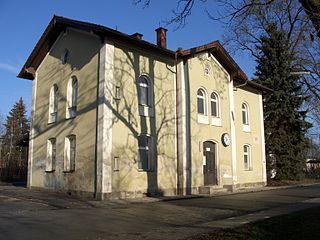
The Wallersdorf–Münchshofen railway was a metre gauge railway in the province of Lower Bavaria in southern Germany. It was operated from 1926 to the end of 1949 by the Wallersdorf and Country Narrow-Gauge Railway Cooperative whose head office was in Büchling. The line started from the station in the market town of Wallersdorf, in Dingolfing-Landau district, and ran to Münchshöfen in the municipality of Oberschneiding, in Straubing-Bogen district. The railway was exclusively used by goods trains.
Keith Archibald Smith, OBE, AM, MIE Aust, FCIT, was Chief Mechanical Engineer, and later Commissioner, for the Commonwealth Railways of Australia, which operates mostly in remote and desolate areas railways for the Federal Government.
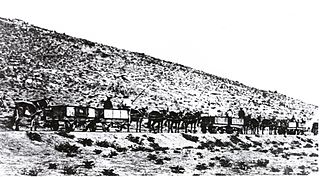
The Namaqualand 0-6-0T of 1871 were two South African steam locomotives from the pre-Union era in the Cape of Good Hope.
A new wagon numbering system was adopted in Indian Railways in 2003. Wagons are allocated 11 digits, making it easy for identification and computerization of a wagon's information. The first two digits indicate Type of Wagon, the third and fourth digits indicate Owning Railway, the fifth and sixth digits indicate Year of Manufacture, the seventh through tenth digits indicate Individual Wagon Number, and the last digit is a Check digit.

The passenger train locomotives number 27–29 of Stockholm–Roslagens Järnvägar, usually referred to as stortyskarna, were the largest steam locomotives ever built for the Swedish three foot gauge railways. Initially used in fast passenger trains from Stockholm to Rimbo and Hallstavik, they were moved to freight service after the Stockholm–Rimbo Line was electrified in 1946. They hauled iron ore from Dannemora mine and transporter wagons from Uppsala, but were replaced by diesel locomotives during the 1950s. Two locomotives were leased at different times to the narrow-gauge network in Västergötland. Their last service was between Rimbo and Hallstavik in 1960. SRJ 28 has been preserved.














